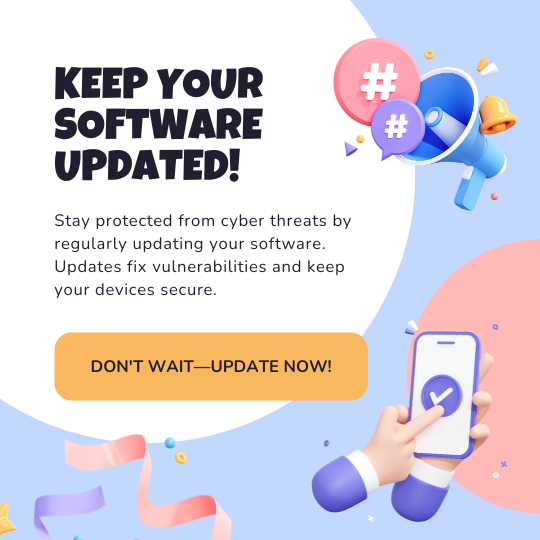In today’s digital age, our lives are increasingly intertwined with technology. We rely on computers, smartphones, and other internet-connected devices for everything from work and communication to entertainment and shopping. While these devices offer incredible convenience and connectivity, they also expose us to potential threats from hackers and cybercriminals. One of the most effective ways to protect yourself from these threats is to keep your software up to date.
Why Software Updates Matter
Software updates are more than just new features and improvements. They often include critical security patches that fix vulnerabilities that hackers could exploit to gain unauthorized access to your devices or data. When you neglect to install these updates, you essentially leave your digital doors unlocked, making it easier for hackers to break in.
Here’s a closer look at why software updates are so crucial:
-
Patching Security Holes: Software developers are constantly working to identify and fix vulnerabilities in their products. Hackers are also actively looking for these weaknesses to exploit. When you install updates, you’re essentially closing these security holes before hackers can take advantage of them.
-
Protecting Against New Threats: The cyber threat landscape is constantly evolving. New viruses, malware, and hacking techniques emerge regularly. Software updates often include protections against these emerging threats, helping you stay one step ahead of the bad guys.
-
Improving Performance and Stability: While security is the primary reason to update your software, updates can also enhance the performance and stability of your devices. They may fix bugs, improve compatibility with other software, and optimize resource usage.
How to Keep Your Software Up to Date
Fortunately, keeping your software up to date is usually a straightforward process. Here are some essential steps to follow:
-
Enable Automatic Updates: Most operating systems and software programs have options to enable automatic updates. This ensures that you receive the latest security patches and improvements without having to remember to check for them manually.
-
Use Secure Web Browsers: Web browsers are a common entry point for hackers. Choose browsers like Chrome or Firefox that have a good track record of security and receive frequent automatic updates.
-
Update Browser Plug-ins: Plug-ins like Flash, Java, and others can also be vulnerable to attacks. Make sure you keep them updated or disable them if you don’t need them.
-
Don’t Ignore Update Notifications: When you see a notification that a software update is available, don’t put it off. Install it as soon as possible to protect yourself from potential threats.
We Are All Targets
It’s important to remember that anyone can be a target for hackers. Cybercriminals don’t discriminate based on age, profession, or technical expertise. Whether you’re a casual internet user or a tech-savvy professional, keeping your software updated is essential for protecting your personal information, financial data, and overall digital security.
By taking the simple steps outlined above, you can significantly reduce your risk of falling victim to cyberattacks and ensure that your digital life remains safe and secure. Remember, staying vigilant and proactive about software updates is one of the most important things you can do to defend yourself in the ever-changing world of cybersecurity.
Feeling lost in the digital world? Dr. Tom is here to help!
Join Dr. Tom every week in his column, Dr. Tom’s Cyber Bits and Tips, for byte-sized advice on all things cyber and tech. Whether you’re concerned about online safety, curious about the latest cybercrime trends, or simply want to navigate the ever-evolving digital landscape, Dr. Tom has you covered.
From practical cybersecurity tips to insightful breakdowns of current threats, Dr. Tom’s column empowers you to stay informed and protect yourself online. So, dive in and get savvy with the web – with Dr. Tom as your guide!
About Dr. Tom
Thomas Hyslip currently serves as an Assistant Professor of Instruction in the Department of Criminology, University of South Florida teaching exclusively in the online Master of Science in Cybercrime program. The program is a unique blend of criminology, digital forensics, cybercrime investigations, and incident response course work.
Prior to USF, Dr. Hyslip worked as a Special Agent with the Defense Criminal Investigative Service (DCIS) and United States Secret Service for 23 years. While assigned to the DCIS Southeast Field Office, Dr. Hyslip led an undercover operation dedicated to targeting and dismantling the most egregious cyber-criminal enterprises. Dr. Hyslip worked with the National Security Agency, and the United States Cyber Command to identify and infiltrate cyber-criminal organizations targeting the DoD.
In 2012, Dr. Hyslip was promoted to lead the newly created Department of Defense, Defense Criminal Investigative Service (DCIS), Cyber Resident Agency. He led daily procedural and operational activities of special agents in eight locations across the eastern United States responding to computer intrusions within the DoD and the Defense Industrial Base. His office also provided computer forensic support to all DCIS offices and investigations within the Eastern United States, Europe, Africa and Southwest Asia. During this time, Dr. Hyslip worked proactively to target international Cyber-Crime groups and worked undercover to penetrate underground cyber-crime organizations which resulted in the dismantlement of the WebStresser DDoS platform in 2018; the ExoStresser DDoS platform in 2019; and the PowerStresser DDoS platform in 2020.
Dr. Hyslip is also a retired U.S. Army Colonel. His last assignment was as a Historian with the U.S. Army Center of Military History. He was previously assigned to the Office of the Surgeon General as an Environmental Engineer, and as an Assistant Professor of Preventive Medicine at the F. Edward Hébert School of Medicine, Uniformed Services University of the Health Sciences. COL Hyslip has a mix of active duty and reserve assignments spanning over 27 years including assignments with the US African Command, Office of Inspector General, the Department of Defense, Office of Inspector General, and the US Army Reserve Information Operations Command. In 2005, COL Hyslip deployed to Iraq with the 306th Military Police Battalion and earned a Bronze Star, Purple Heart, and Combat Action Badge.
Dr. Hyslip earned his Doctor of Science degree in Information Assurance from Capitol College, Master of Science degree in Technology Systems from East Carolina University, and his Bachelor of Science degree in Mechanical Engineering from Clarkson University. Tom and his wife Susan live in Tega Cay, SC with their daughter Reagan











